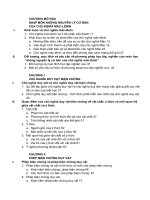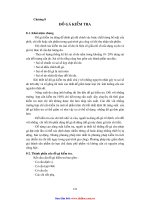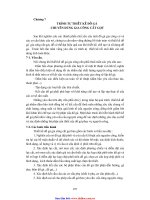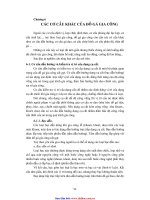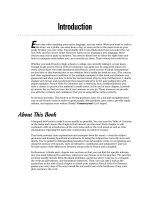Giáo trình động từ tiếng Pháp - Mở đầu pot
Bạn đang xem bản rút gọn của tài liệu. Xem và tải ngay bản đầy đủ của tài liệu tại đây (171.22 KB, 4 trang )
Introduction
E
very day when speaking your native language, you use verbs. When you want to walk to
the store,
eat a pickle, run away from a dog, or even just be in the same room as your
pesky brother, you use verbs. You probably don’t even think about how you select the cor-
rect verb and the correct tense. However, when you’re studying a new language, these
choices may not be quite as intuitive. You need to know how to select the right tense and
how to conjugate verbs before you can correctly use them. That’s where this book fits in.
Whether you took French in high school or college, are currently taking it, or just know
enough to get you by,
French Verbs For Dummies can guide you in using verb tenses cor-
rectly. (If you have very little familiarity with French, check out the “Foolish Assumptions”
section later in this Introduction to see whether this is really the book for you.) The concise
and clear explanations in addition to the multiple examples in this book can eliminate any
guesswork and show you how to form the various tenses step by step. Furthermore, I clearly
explain verb tenses and moods from the present indicative to the past subjunctive with
ample examples.
French Verbs For Dummies isn’t a textbook, but a workbook where you
have a chance to practice the material in small doses. At the end of each chapter, I provide
an answer key so that you can check your answers as you go. These answers can provide
you with the certainty and confidence that you’re using all the verbs correctly.
So sit back and relax. This book is no boring grammar class. It’s a fun and straightforward
way to use French verbs in order to greet people, ask questions, give orders, provide expla-
nations, and express your wishes. Ready?
Commençons! (Let’s begin!)
About This Book
I designed this book to make it as accessible as possible. You can scan the Table of Contents
or the Index and choose the chapters that interest you the most. Each chapter is self-
contained, with an introduction of the verb tense and/or the verb mood as well as clear
explanations regarding the particular construction on which it focuses.
This book provides clear explanations and examples from the onset — from the subject
pronouns and forming hypothetical sentences to using the subjunctive correctly and confi-
dently. You’re guided in distinguishing transitive from intransitive verbs, in recognizing and
using the various verb moods, such as indicative, conditional, and subjunctive; and you
become aware of the differences between using verbs in French and in English.
Furthermore, I divide each chapter into sections so that you can find the specific informa-
tion you need, followed by exercises, which you can choose to do for practice. The practice
sections usually include fill-in-the-blank problems, questions where I ask you to conjugate
the verbs in parentheses, and translation sentences. Then, you can take a look at the
answer key at the end of each chapter to check your answers.
French Verbs For Dummies
guides you every step of the way toward the successful use of the backbone of any com-
plete sentence: the verb.
03_773883 intro.qxp 8/2/06 1:22 PM Page 1
Conventions Used in This Book
In order to make this book easy to use, I use the following conventions:
ߜ In order for you to easily identify the French, I boldface all French words, including
the complete sentences in the examples, French verbs when they appear by
themselves, and the French verb endings when I show you how to conjugate the
verbs.
ߜ I italicize all the English translations that follow the French terms.
ߜ Verb conjugations appear in verb tables. I boldface each verb ending to empha-
size it.
ߜ In the Answer Key, I provide English translations for all the problems (even when
I don’t ask you to provide the translation) to help you better understand the sen-
tence. These translations are in
italics.
ߜ In the Answer Key, some practice problems may have more than one correct
answer. I provide the most common answer in those instances.
ߜ Before each series of practice problems, I provide a sample question in a Q-and-A
format so that you can see how to answer those questions.
Foolish Assumptions
When writing this book, I made the following assumptions about you, my dear reader:
ߜ You took French classes way back when and you remember very little, but you
want to get a refresher on your verbs.
ߜ You want to gather the bits and pieces and assemble them and apply them to
regular, normal, everyday conversation.
ߜ You have taken quite a few years of French, but you’re still having difficulty dis-
tinguishing between the imperfect and the passé composé (or some other verb
tense that’s giving you headaches).
ߜ You finally want to demystify and master the subjunctive.
If any of these assumptions apply to you, then
French Verbs For Dummies is for you.
However, if you’ve never taken a French course or know very little, I suggest that you
first start with
French For Dummies by Dodi-Katrin Schmidt, Michelle M. Williams, and
Dominique Wenzel (Wiley) or consider enrolling in an introductory French class.
How This Book Is Organized
French Verbs For Dummies is divided into parts, starting with the very basic present
indicative tense and ending with the Appendixes. Each part has multiple chapters
that expand on the general topic of the specific part.
2
French Verbs For Dummies
03_773883 intro.qxp 8/2/06 1:22 PM Page 2
Part I: Living in the Here and Now:
The Present Indicative
This part introduces the subject pronouns and gives some basic verb information.
Furthermore, it introduces and conjugates the present tense of regular verbs,
spelling-change verbs, irregular verbs, and pronominal verbs. This part also intro-
duces the present participle and gerund.
Part II: Using Verbs Correctly with
Questions, Commands, and Such
In this part, I show you how to ask and answer questions, give commands, and go
anywhere in or out of town and then come back. I also cover some verbs that you
can use in common expressions that have a different meaning in French.
Part III: Taking a Look Back: The Past Tenses
This part introduces, forms, and explains the uses of the imperfect, passé composé,
and pluperfect tenses of regular, irregular, and pronominal verbs. It also explains the
difference between the imperfect and the passé composé in order to describe past
events and actions. Also included in this part are two literary past tenses: the passé
simple and the passé antérieur.
Part IV: Looking Ahead: The Future
and the Conditional Tenses
In this part, I show you how to form and use the future, the future perfect, the condi-
tional, and past conditional tenses. I also explain how to make polite requests and
form hypothetical sentences.
Part V: Considering Your Mood:
Subjunctive or Not
This part looks at forming the present and past subjunctive of regular, irregular, and
pronominal verbs. It also explains step by step when and how to use the subjunctive
with certain verbs, verbal expressions, and conjunctions.
Part VI: The Part of Tens
Consisting of two chapters, this part gathers the top tens in French verbs: ten verbs
used the French way and the ten most frequently mixed-up verbs.
3
Introduction
03_773883 intro.qxp 8/2/06 1:22 PM Page 3
Part VII: Appendixes
The appendixes enable you to see at a glance all the various verb conjugations
together. It starts off with a French-to-English verb glossary (Appendix A), an English-
to-French verb glossary (Appendix B), and finishes with Appendix C for irregular
verbs.
Icons Used in This Book
As in every For Dummies book, I use icons to help you find specific information. I
place them on the left-hand margin throughout the book. The icons are
When you see this bulls-eye, you know I’m pointing out tips to help you grasp a spe-
cific concept.
The Remember icon indicates that you need to put this little tidbit in the back of your
mind. I’m telling you something important about the verb or verb conjugation.
I use the Example icon in front of an example that demonstrates the format of a
concept.
The Practice icon tells you that it’s time for you to start the practice exercises. Get
your pencils and pens ready.
Where to Go from Here
The best thing about French Verbs For Dummies is that you can take a look at the
Table of Contents and choose the chapter in which you’re interested or you need
more practice. Now take a chance and just give it a try. Only you know what you don’t
know. Just pick a chapter and go at your own pace. Remember, I’m with you every
step of the way!
4
French Verbs For Dummies
03_773883 intro.qxp 8/2/06 1:22 PM Page 4
